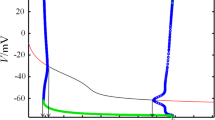Abstract
Chemical blocking is known to affect neural network activity. Here, we quantitatively investigate the dynamic behavior of spiral waves in stochastic Hodgkin–Huxley neuronal networks during sodium- or potassium-ion channel blockages. When the sodium-ion channels are blocked, the spiral waves first become sparse and then break. The critical factor for the transition of spiral waves (x Na) is sensitive to the channel noise. However, with the potassium-ion channel block, the spiral waves first become intensive and then form other dynamic patterns. The critical factor for the transition of spiral waves (x K) is insensitive to the channel noise. With the sodium-ion channel block, the spike frequency of a single neuron in the network is reduced, and the collective excitability of the neuronal network weakens. By blocking the potassium ion channels, the spike frequency of a single neuron in the network increases, and the collective excitability of the neuronal network is enhanced. Lastly, we found that the behavior of spiral waves is directly related to the system synchronization. This research will enhance our understanding of the evolution of spiral waves through toxins or drugs and will be helpful to find potential applications for controlling spiral waves in real neural systems.






Similar content being viewed by others
References
Hodgkin, A.L., Huxley, A.F.: A quantitative description of membrane current and its application to conduction and excitation in nerve. J. Physiol. 117, 500–544 (1952)
Yu, Y., Shu, Y., McCormick, D.A.: Cortical action potential backpropagation explains spike threshold variability and rapid-onset kinetics. J. Neurosci. 28(29), 7260–7272 (2008)
Sun, X., Perc, M., Lu, Q., Kurths, J.: Spatial coherence resonance on diffusive and small-world networks of Hodgkin–Huxley neurons. Chaos 18, 023102 (2008)
Lin, M., Luo, Z.Y., Bai, B.F., Xu, F., Lu, T.J.: Fluid mechanics in dentinal microtubules provides mechanistic insights into the difference between hot and cold dental pain. PLoS ONE 6, e18068 (2011)
Schmid, G., Goychuk, I., Hänggi, P.: Effect of channel block on the spiking activity of excitable membranes in a stochastic Hodgkin–Huxley model. Phys. Biol. 1, 61 (2004)
Schmid, G., Goychuk, I., Hänggi, P.: Controlling the spiking activity in excitable membranes via poisoning. Physica A 344, 665–670 (2004)
Gong, Y.B., Xu, B., Ma, X.G., Han, J.Q.: Effect of channel block on the collective spiking activity of coupled stochastic Hodgkin–Huxley neurons. Sci. China Ser. B 51, 341–346 (2008)
Ozer, M., Perc, M., Uzuntarla, M.: Controlling the spontaneous spiking regularity via channel blocking on Newman–Watts networks of Hodgkin–Huxley neurons. Europhys. Lett. 86, 40008 (2009)
Sun, G.Q.: Pattern formation of an epidemic model with diffusion. Nonlinear Dyn. 69, 1097–1104 (2012)
Sun, G.Q., Jin, Z., Li, L., Li, B.L.: Self-organized wave pattern in a predator–prey model. Nonlinear Dyn. 60, 265–275 (2010)
Vasiev, B., Siegert, F., Weijer, C.: Multiarmed spirals in excitable media. Phys. Rev. Lett. 78, 2489–2492 (1997)
Garfinkel, A., Kim, Y.H., Voroshilovsky, O., Qu, Z., Kil, J.R., Lee, M.H., Karagueuzian, H.S., Weiss, J.N., Chen, P.S.: Preventing ventricular fibrillation by flattening cardiac restitution. Proc. Natl. Acad. Sci. USA 97, 6061 (2000)
Bursac, N., Aguel, F., Tung, L.: Multiarm spirals in a two-dimensional cardiac substrate. Proc. Natl. Acad. Sci. USA 101, 15530 (2004)
Huang, X., Troy, W.C., Yang, Q., Ma, H., Laing, C.R., Schiff, S.J., Wu, J.Y.: Spiral waves in disinhibited mammalian neocortex. J. Neurosci. 24, 9897 (2004)
Davidenko, J.M., Pertsov, A.V., Salomonsz, R., Baxter, W., Jalife, J.: Stationary and drifting spiral waves of excitation in isolated cardiac muscle. Nature 355, 349–351 (1992)
Jalife, J.: Ventricular fibrillation: mechanisms of initiation and maintenance. Annu. Rev. Physiol. 62, 25–50 (2000)
Hu, G., Xiao, J., Chua, L.O., Pivka, L.: Controlling spiral waves in a model of two-dimensional arrays of Chua’s circuits. Phys. Rev. Lett. 80, 1884–1887 (1998)
Ma, J., Tang, J., Zhang, A.H., Jia, Y.: Robustness and breakup of the spiral wave in a two-dimensional lattice network of neurons. Sci. China Ser. G 53, 672–679 (2010)
Ma, J., Wu, Y., Ying, H.P., Jia, Y.: Channel noise-induced phase transition of spiral wave in networks of Hodgkin–Huxley neurons. Chin. Sci. Bull. 56, 151–157 (2011)
Wang, C.N., Ma, J., Liu, Y., Huang, L.: Chaos control, spiral wave formation, and the emergence of spatiotemporal chaos in networked Chua circuits. Nonlinear Dyn. 67, 139–146 (2012)
Ma, J., Huang, L., Tang, J., Ying, H.P., Jin, W.Y.: Spiral wave death, breakup induced by ion channel poisoning on regular Hodgkin–Huxley neuronal networks. Commun. Nonlinear Sci. Numer. Simul. 17, 4281–4293 (2012)
Fox, R.F., Lu, Y.: Emergent collective behavior in large numbers of globally coupled independently stochastic ion channels. Phys. Rev. E 49, 3421 (1994)
Schmid, G., Goychuk, I., Hänggi, P.: Stochastic resonance as a collective property of ion channel assemblies. Europhys. Lett. 56, 22 (2001)
Jung, P., Shuai, J.: Optimal sizes of ion channel clusters. Europhys. Lett. 56, 29 (2001)
Acknowledgements
We thank Dr. Jun Ma for useful discussions and helpful comments. This work is supported by the National Natural Science Foundation of China (11272242, 10972170, and 10602003) and the New Faculty Research Foundation of Xi’an Jiaotong University.
Author information
Authors and Affiliations
Corresponding author
Rights and permissions
About this article
Cite this article
Liu, SB., Wu, Y., Li, JJ. et al. The dynamic behavior of spiral waves in stochastic Hodgkin–Huxley neuronal networks with ion channel blocks. Nonlinear Dyn 73, 1055–1063 (2013). https://doi.org/10.1007/s11071-013-0852-5
Received:
Accepted:
Published:
Issue Date:
DOI: https://doi.org/10.1007/s11071-013-0852-5




